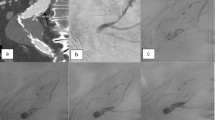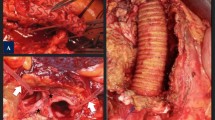Abstract
Purpose
The purpose of our study is to report our experience with the use of an ethylene vinyl alcohol copolymer (Onyx) in an off-label fashion for the treatment of type II endoleak after endovascular repair of the thoracic (TEVAR) and abdominal (EVAR) aorta.
Methods
A retrospective review of patients with type I and/or II endoleak treated with Onyx was performed. Data regarding the technical, clinical, and imaging outcomes were collected. Technical success was defined as decreased or eliminated endoleak on the first imaging follow-up. Clinical success was defined as unchanged or decreased aneurysm sac size on subsequent follow-up.
Results
Eighteen patients (15 male, 3 female) with a mean age of 79 years (range 69–92) met inclusion criteria (16 abdominal aortic aneurysm, 2 thoracic aortic aneurysm). Sixteen patients had type II endoleak, and 2 had complex type II endoleak with a type I component. The interval between endograft placement and treatment was a mean of 30 months. Direct sac treatment approach was used in 13 patients; transarterial approach was used in 3 patients. Seven patients required the use of coils, N-butyl cyanoacrylate glue, or Amplatzer vascular plugs. The average volume of Onyx used per treatment was 5.6 mL (range 2.5–13). Duration of imaging follow-up was 0.75–72.5 months (mean 32.8). Sixteen of 18 (88.9 %) patients had initial technical and clinical success. Two of 18 patients (11.1 %) were initial technical failures, and 1 remained a failure despite a second treatment and attempted surgical ligation. Eight of 18 (44.4 %) of patients eventually required a second intervention, 5 (27.8 %) of them due to delayed clinical failure. Complications included 1 psoas hematoma, 1 transient L2 nerve paresis, and 1 intraperitoneal Onyx leak; all of these were without clinical sequelae.
Conclusion
Onyx with or without coil/glue/Amplatzer plug embolization is safe and useful in the treatment of type II endoleak after TEVAR and EVAR. However, long-term clinical and imaging follow-up is needed for early detection and management of recurrence of the primary endoleak or the development of new, secondary endoleaks or enlargement of the aneurysm sac.



Similar content being viewed by others
References
Coady MA, Ikonomidis JS, Cheung AT, Matsumoto AH, Dake MD, Chaikof EL, et al (2010) AHA council on Cardiovascular Surgery and Anesthesia and Council on Peripheral Vascular Disease Surgical Management of descending thoracic aortic disease: open and endovascular approaches. A scientific statement from the American Heart Association. Circulation 121(25):2780–2804
Chaikof EL, Brewster DC, Dalman RL, Makaroun MS, Illig KA, Sicard GA et al (2009) The care of patients with an abdominal aortic aneurysm: the Society for Vascular Surgery practice guidelines. J Vasc Surg 50(4):S2–S49
Jones JE, Atkins MD, Brewster DC, Chung TK, Kwolek CJ, LaMuraglia GM et al (2007) Persistent type 2 endoleak after endovascular repair of abdominal aortic aneurysm is associated with adverse late outcomes. J Vasc Surg 46(1):1–8
Baum RA, Carpenter JP, Golden MA, Velazques OC, Clark TW, Stavropoulos SW et al (2002) Treatment of type 2 endoleaks after endovascular repair of abdominal aortic aneurysms: comparison of transarterial and translumbar techniques. J Vasc Surg 35(1):23–29
Golzarian J, Maes EB, Sun S (2005) Endoleak: treatment options. Tech Vasc Interv Radiol 8(1):41–49
Maldonado TS, Rosen RJ, Rockman CB, Adelman MA, Bajakian D, Jacobowitz GR et al (2003) Initial successful management of type I endoleak after endovascular aortic aneurysm repair with n-butyl cyanoacrylate adhesive. J Vasc Surg 38(4):664–670
Peynircioğlu B, Türkbey B, Ozkan M, Cil BE (2008) Use of glue and microcoils for transarterial catheter embolization of a type 1 endoleak. Diagn Interv Radiol 14(2):111–115
Martin ML, Dolmatch BL, Fry PD, Machan LS (2001) Treatment of type II endoleaks with Onyx. J Vasc Interv Radiol 12(5):629–632
Mansueto G, Cenzi D, Scuro A, Gottin L, Griso A, Gumbs AA et al (2007) Treatment of type II endoleak with a transcatheter transcaval approach: results at 1-year follow-up. J Vasc Surg 45(6):1120–1127
White S, Stavropoulos S (2009) Management of endoleaks following endovascular aneurysm repair. Semin Intervent Radiol 26(1):33–38
Onyx liquid embolic system [package insert] (2007) Neurovascular, eV3. Irvine, CA
Weber W, Kis B, Siekmann R, Kuehne D (2007) Endovascular treatment of intracranial arteriovenous malformations with onyx: technical aspects. AJNR Am J Neuroradiol 28(2):371–377
Bobadilla JL, Hoch JR, Leverson GE, Tefera G (2010) The effect of warfarin therapy on endoleak development after endovascular aneurysm repair (EVAR) of the abdominal aorta. J Vasc Surg 52(2):267–271
Fanelli F (2013) ONYX: A liquid embolic material for the treatment of type II endoleaks and arterio-venous fistulas and malformations, p 1–4. Available from: http://www.aimsymposium.org/pdf/vei/2046.pdf. Accessed 28 March 2013
Massis K, Zwiebel B, Carson WG (2010) Abstract no. 289: transarterial embolization of type II endoleaks using ethylene-vinyl-alcohol copolymer. J Vasc Interv Radiol 21:S109–S110
Nevala T, Biancari F, Manninen H, Aho PS, Matsi P, Makinen K et al (2010) Type II endoleak after endovascular repair of abdominal aortic aneurysm: effectiveness of embolization. Cardiovasc Interv Radiol 33(2):278–284
Ling AJ, Pathak R, Garbowski M, Nadkarni S (2007) Treatment of a large type II endoleak via extraperitoneal dissection and embolization of a collateral vessel using ethylene vinyl alcohol copolymer (Onyx). J Vasc Interv Radiol 18(5):659–662
Grisafi JL, Boiteau G, Detschelt E, Potts J, Kiproff P, Muluk SC (2010) Endoluminal treatment of type IA endoleak with Onyx. J Vasc Surg 52(5):1346–1349
Massis K, Carson WG, Rozas A, Patel V, Zwiebel B (2012) Treatment of type II endoleaks with ethylene-vinyl-alcohol copolymer (Onyx). Vasc Endovasc Surg 46(3):251–257
Abularrage CJ, Patel VI, Conrad MF, Schneider EB, Cambria RP, Kwolek CJ (2012) Improved results using Onyx glue for the treatment of persistent type 2 endoleak after endovascular aneurysm repair. J Vasc Surg 56(3):630–636
Nevala T (2010) Endovascular treatment of an abdominal aortic aneurysm. Dissertation. Acta Universitas, Oulu
Görich J, Rilinger N, Sokiranski R, Kramer SC, Erms C, Schutz A et al (2000) Treatment of leaks after endovascular repair of aortic aneurysms. Radiology 215(2):414–420
Baum RA, Stavropoulos SW, Fairman RM, Carpenter JP (2003) Endoleaks after endovascular repair of abdominal aortic aneurysms. J Vasc Interv Radiol 14(9):1111–1117
Stavropoulos SW, Kim H, Clark TWI, Fairman RM, Velazquez O, Carpenter JP (2005) Embolization of type 2 endoleaks after endovascular repair of abdominal aortic aneurysms with use of cyanoacrylate with or without coils. J Vasc Interv Radiol 16(6):857–861
Stavropoulos SW, Charagundla SR (2007) Imaging techniques for detection and management of endoleaks after endovascular aortic aneurysm repair. Radiology 243(3):641–655
Stavropoulos SW, Park J, Fairman R, Carpenter J (2009) Type 2 endoleak embolization comparison: translumbar embolization versus modified transarterial embolization. J Vasc Interv Radiol 20(10):1299–1302
Rosen RJ, Green RM (2008) Endoleak management following endovascular aneurysm repair. J Vasc Interv Radiol 19(6):S37–S43
Jonker FHW, Aruny J, Muhs BE (2009) Management of type II endoleaks: preoperative versus postoperative versus expectant management. Semin Vasc Surg 22(3):165–171
Keedy AW, Yeh BM, Kohr JR, Hiramoto JS, Schneider DB, Breiman RS (2011) Evaluation of potential outcome predictors in type II endoleak: a retrospective study with CT angiography feature analysis. AJR Am J Roentgenol 197(1):234–240
Noel Parent F, Meier GH, Godziachvili V, LeSar CJ, Parker FM, Carter KA et al (2002) The incidence and natural history of type I and II endoleak: a 5-year follow-up assessment with 1 color duplex ultrasound scan. J Vasc Surg 35(3):474–481
Fairman RM, Carpenter JP, Baum RA, Larson RA, Golden MA, Barker CF et al (2002) Potential impact of therapeutic warfarin treatment on type II endoleaks and sac shrinkage rates on midterm follow-up examination. J Vasc Surg 35(4):679–685
Timaran CH, Ohki T, Rhee SJ, Veith FJ, Gargiuo NJ 3rd, Toriumi H et al (2004) Predicting aneurysm enlargement in patients with persistent type II endoleaks. J Vasc Surg 39(6):1157–1162
Arko FR, Filis KA, Siedel SA, Johnson BL, Drake AR, Fogarty TJ et al (2003) Intrasac flow velocities predict sealing of type II endoleaks after endovascular abdominal aortic aneurysm repair. J Vasc Surg 37(1):8–15
Bargellini I, Napoli V, Petruzzi P, Cioni R, Vignali C, Sardella SG et al (2005) Type II lumbar endoleaks: hemodynamic differentiation by contrast-enhanced ultrasound scanning and influence on aneurysm enlargement after endovascular aneurysm repair. J Vasc Surg 41(1):10–18
Panagiotopoulos V, Gizewski E, Asgari S, Regel J, Forsting M, Wanke I (2009) Embolization of intracranial arteriovenous malformations with ethylene-vinyl alcohol copolymer (Onyx). AJNR Am J Neuroradiol 30(1):99–106
Stone JR, Evans AJ, Angle JF, Arslan B, Turba UC, Matsumoto AH (2009) In vitro assessment of aortic stent-graft integrity following exposure to onyx liquid embolic agent. J Vasc Interv Radiol 20(1):107–112
Akin ED, Perkins E, Ross IB (2003) Surgical handling characteristics of an ethylene vinyl alcohol copolymer compared with N-butyl cyanoacrylate used for embolization of vessels in an arteriovenous malformation resection model in swine. J Neurosurg 98(2):366–370
Conflict of interest
Avery J. Evans is a consultant and proctor for eV3 Neurovascular. J. Fritz Angle is a consultant for Terumo Medical and received a grant from Siemens Medical. Alan H. Matsumoto sits on the Data Safety Monitoring Board for the Trivascular, Bolton Medical, Boston Scientific, and Medicines companies; has received institutional grants from W. L. Gore, Medtronic, Cook Medical, and InSightec; holds personal stock or stock options of Crux Medical; and has received other travel/accommodations/meeting expenses from Siemens Medical. None of these are relevant to this manuscript.
Author information
Authors and Affiliations
Corresponding author
Rights and permissions
About this article
Cite this article
Khaja, M.S., Park, A.W., Swee, W. et al. Treatment of Type II Endoleak Using Onyx With Long-Term Imaging Follow-Up. Cardiovasc Intervent Radiol 37, 613–622 (2014). https://doi.org/10.1007/s00270-013-0706-z
Received:
Accepted:
Published:
Issue Date:
DOI: https://doi.org/10.1007/s00270-013-0706-z




